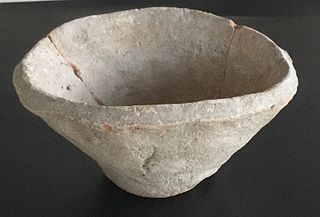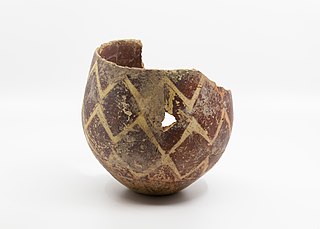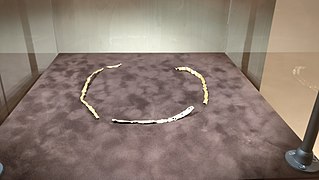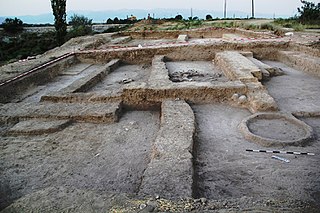
The Ubaid period is a prehistoric period of Mesopotamia. The name derives from Tell al-'Ubaid where the earliest large excavation of Ubaid period material was conducted initially in 1919 by Henry Hall and later by Leonard Woolley.

The Kura–Araxes culture was an archaeological culture that existed from about 4000 BC until about 2000 BC, which has traditionally been regarded as the date of its end; in some locations it may have disappeared as early as 2600 or 2700 BC. The earliest evidence for this culture is found on the Ararat plain; it spread north in the Caucasus by 3000 BC.

The Maykop culture or Maikop culture, c. 3700 BC–3000 BC, is a major Bronze Age archaeological culture in the western Caucasus region.

Arslantepe, also known as Melid, was an ancient city on the Tohma River, a tributary of the upper Euphrates rising in the Taurus Mountains. It has been identified with the modern archaeological site of Arslantepe near Malatya, Turkey.

The Shulaveri–Shomu culture, also known as the Shulaveri-Shomutepe-Aratashen culture, is an archaeological culture that existed on the territory of present-day Georgia, Azerbaijan, and Armenia, as well as parts of northern Iran during the Late Neolithic/Eneolithic. It lasted from around the end of the seventh millennium BC to the beginning of the fifth millennium BC.
Godin Tepe is an archaeological site in western Iran, located in the valley of Kangavar in Kermanshah province. The importance of the site may have been due to its role as a trading outpost in the early Mesopotamian trade networks.
Tepe Gawra is an ancient Mesopotamian settlement 15 miles NNE of Mosul in northwest Iraq that was occupied between 5000 and 1500 BC. It is roughly a mile from the site of Nineveh and 2 miles E of the site of Khorsabad. It contains remains from the Halaf period, the Ubaid period, and the Uruk period. Tepe Gawra contains material relating to the Halaf-Ubaid Transitional period c. 5,500–5,000 BC.
Aratashen is a town in the Armavir Province of Armenia. It is located on the Ararat Plain.
Böyük Kəsik is a village and municipality in the Aghstafa District of Azerbaijan. It has a population of 1,791.

Kültəpə is a settlement dating from the Neolithic, a village and municipality in the Babek District of Nakhchivan, Azerbaijan. It has a population of 1,859.

The Leyla-Tepe culture of the South Caucasus belongs to the Chalcolithic era. It got its name from the site in the Agdam District of modern-day Azerbaijan. Its settlements were distributed on the southern slopes of Central Caucasus, from 3800 until 3200 B.C.

Beveled rim bowls are small, undecorated, mass-produced clay bowls most common in the 4th millennium BC during the Late Chalcolithic period. They constitute roughly three quarters of all ceramics found in Uruk culture sites, are therefore a unique and reliable indicator of the presence of the Uruk culture in ancient Mesopotamia.
Kul Tepe Jolfa is an ancient archaeological site in the Jolfa County of Iran, located in the city of Hadishahr, about 10 km south from the Araxes River.

Dalma culture was a prehistoric archaeological culture of north-western Iran dating to early fifth millennium B.C. Later, it spread into the central Zagros region and elsewhere in adjacent areas. Its widespread ceramic remains were excavated in central and northern valleys of the Zagros Mountains in north-western Iran. Dalma assemblages were initially discovered by the excavations carried out at Dalma Tepe and Hasanlu Tepe in south-western parts of Lake Urmia, in the valley of Solduz.
Uçan ağıl is an archaeological site north of Sirab village in Babek District of Nakhchivan Autonomous Republic, Azerbaijan. It is located at the altitude of 1200 m a.s.l. in the Sirab piedmonts, in the upper reaches of Sirab Suyu river along with other sites from the same period, Sorsu, and Zirinclik. It is dated at ca 4850-4350 BC time span, but was also occupied in the 3rd millennium BC. Uçan Ağıl was likely used by mobile pastoralists on a seasonal basis. They mostly pastured herds of goats.

Ovçular Tepesi is an ancient settlement located at the northern end of Dizə, Sharur village in Sharur District of Azerbaijan, on the left bank of Arpa (river). It dates back to the fifth millennium BC, and continued to the third millenniums BC.

Godedzor is a prehistorical archaeological site located about 1,5 kilometres west of the village of Angeghakot in the Syunik Province of Armenia. The settlement of Nerkin Godedzor is in the Vorotan river gorge, at the altitude of 1800 meters. Some petroglyphs are also found close by.
Galayeri is an important archaeological site of the Chalcolithic era located in the Qabala District of Azerbaijan. It belongs to the Leyla-Tepe culture.

Nakhchivan Tepe (Naxçıvantəpə) is a Chalcolithic settlement in Nakhchivan, Azerbaijan. It is located in Nakhchivan (city) and is dated to the first half of the 5th millennium BC. It is on the right bank of the Nakhchivançay river at the altitude of 850m.
Hacınebi Tepe is an ancient Near East archaeological site 3.5 kilometers north of the modern town of Birecik and near the Euphrates river crossing between Apamea and Zeugma in Şanlıurfa Province, Turkey. The area marks the northernmost easily navigable route of the Euphrates River. The site was occupied in the 4th millennium BC by a local population, joined by an enclave of the Uruk culture in the middle of that millennium. It was then abandoned aside from occasional use for burials, until the Hellenistic period when it was again fully occupied. The sites final use was as a Roman farmstead.












